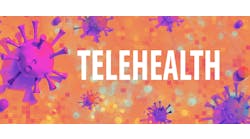Phoenix Children’s Hospital’s Success Story: A Rapid Transition to Telehealth, With High Satisfaction All Around
Earlier this spring, long before COVID-19 had surged dramatically in Arizona, leaders at Phoenix Children’s Hospital moved forward quickly to put into place processes and technologies to support the transition to widespread virtual care. The hospital’s leaders transitioned over 6,000 weekly appointments from in-person visits to telehealth in under a week in April. Meanwhile, the hospital’s telehealth dashboard is seamlessly integrating real-time data on patient visits for executives, physicians and schedulers. The fully automated system provides organization-wide and department-specific information - like which patients can be moved to video or phone, and which must be seen in-person - but also drills down to actionable items, like providing a daily call list for each of Phoenix Children's more than 100 schedulers and auto-texting families when schedulers can't reach them by phone.
In under seven days, the dashboard allowed the health system’s 31 divisions to move patients without interruption from in-person to telehealth. In some departments, 90 percent of patient visits are now conducted via telehealth offerings. The fully automated system provides organization-wide and department-specific information - like which patients can be moved to video or phone, and which must be seen in-person - but also drills down to actionable items, like providing a daily call list for each of Phoenix Children's more than 100 schedulers and auto-texting families when schedulers can't reach them by phone.
Late this spring, Vinay Vaidya, M.D., Phoenix Children’s Hospital’s CMIO, spoke with Healthcare Innovation Editor-in-Chief Mark Hagland regarding the hospital’s innovative work in this area. Below are excerpts from their interview.
Tell me about the advances you’ve made this spring with regard to telehealth-facilitated care delivery?
Our hospital shifted quickly to telemedicine, as have other hospitals. But it’s really no different from FaceTime with property security. So that technology has been there for many years. What really helped us has been using our data to manage things, kind of like Amazon. Who needs to be seen, who need to be managed. What really helped us was using our existing warehouse, which gets all kinds of data from all types of systems, and very quickly creating an operational dashboard that everyone could access.
When did you begin to put things into place, and when did you develop the dashboard?
Before COVID-19 hit, we didn’t have a full-fledged, fully established telemedicine program. All the visits were in-person. The week of March 15, it started moving to phone first. And then as we moved forward, we saw a dramatic increase in our telemedicine visit. So now we’re between 55 and 60 percent telemedicine each week.
What were the challenges in shifting so quickly?
The challenges fell into two or three buckets: one was around technology, the others were around providers and patients. We did not have a formally established telemedicine program or vendor offering. We were using Zoom, GoToMeeting, and WebEx. So our physicians were familiar with the platform for meetings. So one challenge was quickly establishing the format; the second was achieving rapid adoption. And the third was, how do you get the physicians to triage their 6,000-7,000 patients? There are patients who come in for chemotherapy or labs every week who can’t be seen via telemedicine. But the starting point is the physician decision as to who should be a telemedicine visit. So it was an operational nightmare with 6,000 patients a week involved; that was not sustainable. And we know that technology has its challenges. But if it’s going to benefit the patients, we’re going to do it.
And none of the physicians were psychologically resistant, per se, correct?
That’s correct.
What have you learned so far in this?
We learned that speed is of the essence; communication is of the essence. We have a small, nimble IT force. And the development teams are 8-10 people in each group. And it wasn’t anything remarkable; it’s that data is the king, that data is the DNA, that data is the driving force that can make you nimble, competent, and effective, in providing patient care. Of course, there are security challenges; and our security team was watching this very closely. And one of our strengths has been that we are not in the business of software development; we’re in the business of taking care of children. In this case, we took the Zoom platform and developed a slender layer of vendor APIs and quickly created a web conferencing platform, where you could have the interpreter join in or the dietician, etc. And it took about two weeks. We were already using Zoom. So now we have a very robust telemedicine platform. You really need the icing on the cake, to make an initiative truly successful.
And parents have been largely accepting of the shift?
Yes, the families have been absolutely thrilled; not only does this shift enhance personal safety; it also makes And one physician said, I never realized what a different setting it is when I’m speaking with the family in their home. They let their guard down and share a great amount of information. The clinic setting can be very intimidating. So it’s not only the comfort; that physician said he got much more valuable information.
What advice would you like to share with colleagues nationwide, based on your organization’s experience?
The key pieces are, get the right people together. All of us are trying to solve a problem. And make the team not too big or too small—have a core small team to make rapid decisions and be nimble and not get bogged down in the bureaucracy. Have a data team to support all the key decisions.
And so here I’m showing you a screenshot of the dashboard. On the left-hand side is for my clinical supervisors, who know that 2,623 appointments have to be managed across 7 days. 2,039 have been reviewed, 584 not yet reviewed. Those 584 need to be reviewed, and you can see what areas they’re in. Then they need to be prioritized, using algorithms. Once the schedulers make a call, and if they can’t reach someone, they indicate voice message left. So it’s very efficient. And only 70 need to be changed to telemedicine. And so the schedulers can look at a dashboard customized for them, to help them manage appointments, and when appropriate shift them to Zoom video calls. So all of this technology involves no one having to work the phones, and everyone can see what’s happening in near-real time.
Overall, patient and clinician satisfaction have been high, then, correct?
It has been overwhelmingly positive. And it is not just through the lens of social distancing. There has been an overwhelmingly positive reaction. This is a very spread out area. And overwhelming satisfaction from our clinicians as well as from patients and families.
What might happen in the next year or so?
This spring, we went from zero to 90 percent in an incredibly brief period of time. And post-COVID, [the proportion of patient visits that will take place via telehealth] will be somewhere in between. And every decision will be driven by data. We have to be able to stratify and identify patients ideal for telemedicine based on their clinical situations; and 90 percent of decision-making is based on data. We know by division and by disease, which patients need to be seen in person or can be seen remotely. We’ve all been making a lot of promises about healthcare information technology. But we need the tools to rapidly adapt to the new circumstances.


